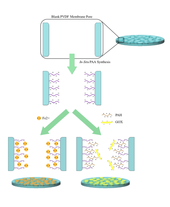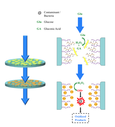Highlight
Development of Functionalized Membranes For Free Radical Production at Interfaces
Achievement/Results
A group of IGERT investigators from the Department of Chemical Engineering and the Department of Chemistry have developed functionalized membranes for free radical production at interfaces. The generation of the highly reactive free radical production is achieved via the reaction of iron ions with hydrogen peroxide. To achieve this, the investigators have developed a novel approach to immobilize the enzyme glucose oxidase (GOX) in pores of membrane materials by layer-by-layer (LbL) assembly of polycations and polyanions. These membranes provide a bioactive layer for hydrogen peroxide production from a readily available substrate, glucose. These membranes along with another membrane (polyvinylidene fluoride (PVDF) functionalized with polyacrylic acid (PAA)) containing immobilized iron ions create a potential interface to form free radicals. By convectively passing hydrogen peroxide through the membrane containing iron, we are able to generate hydroxyl radicals which can be used for various purposes, including disinfection and oxidation of unwanted organics. The investigators have demonstrated an increased reaction rate for these iron-immobilized systems compared to conventional homogeneous phase reactions as well as extended use over a broader pH range. This is the first time that simultaneous production of H2O2 and free hydroxyl radicals inside the pores of a composite bioactive membrane reactor for free radical reactions has been achieved. The investigators also demonstrated that this system is capable of degrading target model compounds, such as trichlorophenol.
Steady-state hydrogen peroxide degradation in a PAA/PVDF membrane containing Fe(III) showed first order reaction kinetics (modeled as a continuous stirred-tank reactor). This rate is approximately one order of magnitude greater than what would be expected from the literature-reported Fe(III) and hydrogen peroxide reaction kinetics, indicating an increased rate of hydrogen peroxide degradation for Fe(III) in its carboxylate complex form. In order to better understand the mechanism by which hydroxyl radicals are generated by the reaction of the ion-exchanged iron and hydrogen peroxide, it is important to quantify their production. This was accomplished through the use of a radical probe, such as benzoic acid. By varying hydrogen peroxide concentration and residence time, the rate of hydroxyl radical production can be altered, therefore determining both the extent and rate of benzoic acid oxidation.
The IGERT program at the University of Kentucky focuses on three themes: synthetic architectures, cell/protein interactions with these architectures, and integration into devices. This project is a prime example of investigators working together within these themes to create a device consisting of a membrane with immobilized proteins with applications in treatment of waste.
Address Goals
This project focuses on protein interactions with membrane interfaces for applications in waste treatment. It advances knowledge in the area of Bioactive Interfaces and demonstrates how this area of research can be used to develop a valuable device. This project also demonstrates the importance of interdisciplinary research as it could not have been accomplished without Chemists and Chemical Engineers working together to achieve the final goal.







